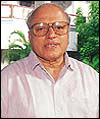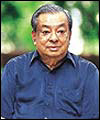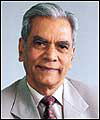 1
Monkombu Sambasivan Swaminathan 1
Monkombu Sambasivan Swaminathan
The Green Geneticist
If the dire Malthusian worldview (of population outstripping food
production) did not prevail in India, it's probably due to M.S. Swaminathan.
Armed with a PhD from Cambridge,he returned to India in 1954 and joined
Delhi's Indian Agricultural Research Institute. With foodgrain production
stagnating, the country was close to famine. Swaminathan provided
the miracle that everybody had been hoping for. Taking a leaf from
Mexico's Green Revolution, he cross-bred the high-yield Mexican wheat
strain with an Indian variety. By 1978-89, India had a record 131
million tonne harvest. In 1987, he was awarded the World Food Prize,
followed by Tyler and Honda in 1991, and the UNEP Sasakwa Award in
1994. Now Swaminathan, 76, is pushing for an 'evergreen revolution'-a
way to sustain India's agricultural miracle.
(See exclusive column in this section)
 2
Verghese Kurien 2
Verghese Kurien
The Milk Man
In 2000, India emerged as the world's largest milk producer.
All because 50 years ago, a young man named Verghese Kurien joined
the Kaira District Co-operative Milk Producers' Union in Anand,
Gujarat, as a manager. Starting with two village cooperatives and
250 litres of milk per day, Kurien went on to create India's White
Revolution. His Operation Flood, launched in 1970, followed a simple
structure (called the Anand Pattern): at the core were farmers and
the co-operatives; on top was a district-level milk producers' union,
and finally there was a state federation that did the marketing.
The National Dairy Development Board, which Kurien founded in 1963
(he won the Ramon Magsaysay Award for Community Leadership in the
same year), today runs a co-operative network comprising 170 milk
unions and 10.7 million farmer members. The 80-year-old Kurien retired
in 2000 as NDDB's chairman.
 3
Faqir Chand Kohli 3
Faqir Chand Kohli
Father of Indian Software Industry
As an electrical engineer, F.C. Kohli was an unlikely candidate
to be India's software revolutionary. But, as it turned out, J.R.D.
Tata couldn't have picked a better man to lead the Tata group's
foray into the then esoteric software business. When Kohli took
over the reins at Tata Consultancy Services in 1969, the electrical
engineer from the Massachusetts Institute of Technology only had
experience in managing power plants. Worse, computer technology
wasn't really a priority for the government. Kohli battled on, managing
to get a modest share of the software boom that had begun in the
US in the early 60s. The arrival of Rajiv Gandhi and his technology-friendly
team opened up opportunities for TCS, and a horde of other software
wannabes. Today, TCS is Asia's largest software and services company,
and set to cross the $1-billion turnover mark (Rs 4,700 crore) in
2001-02.
 4
Kiran Mazumdar Shaw 4
Kiran Mazumdar Shaw
Biotech Baroness
It's rare for a woman to be the CEO of a company that leads
its industry. It's rarer still for that woman to also have pioneered
the industry. But then, Kiran Mazumdar Shaw is no ordinary woman.
When she returned from the UK with a master's degree in brewing
(her father R.I. Mazumdar was India's first brew master), she was
all of 25 years old. Her original idea was to take up a job as a
brewmistress. But fate willed otherwise. As it happened, she couldn't
find a job. Far from being deterred, the young Mazumdar launched
her own company with Biocon, an Irish firm, to manufacture enzymes
for packaged fruit juices. Today, Biocon (the Irish partner sold
out to Mazumdar Shaw in 1999) is India's largest biotech company
with revenues of about Rs 200 crore, and focused on pharma products
such as anti-infectives. It also has a subsidiary called Helix that
carries out Biocon's biopharm operations. The industry estimates
to generate $20 billion (Rs 94,000 crore) by the end of 2005. Don't
be surprised if Mazumdar Shaw ends up with an increasingly bigger
share of it.
 5
Ramesh Chandra Sinha 5
Ramesh Chandra Sinha
The Super Bureaucrat
Call him India's unsung infrastructure hero. Despite 58 writ
petitions against his Mumbai-Pune Expressway Project, bureaucrat
Ramesh Chandra Sinha-then the Vice Chairman and Managing Director
of Maharashtra State Road Development Corporation between 1997 and
2000-acquired 1,100 hectares of land and raised Rs 1,600 crore in
a record 11 months. Earlier, as the Managing Director of City &
Industries Development Corporation, Maharashtra (CIDCO), he spearheaded
the development of Navi Mumbai, New Nashik, New Aurangabad, New
Nanded, and the district headquarters of Sindhdargh. For his work,
he was awarded the C.D. Deshmukh award by the President of India
in 1994. Now retired, Sinha has been roped in by Andhra Pradesh
Chief Minister Chandra Babu Naidu to head India's first National
Academy of Construction (expected to be ready by March 2002), and
also advice the state on infrastructure. To those who curse administrative
red tape, Sinha is a shining example of innovative and dedicated
bureaucracy.
 6
P.C. Mahalanobis 6
P.C. Mahalanobis
India's Quality Guru
Prasanta Chandra Mahalanobis was India's answer to the American
quality guru Edwards W. Deming. Just like his American peer, Mahalanobis
was a statistician. And like Deming, Mahalanobis (called 'Professor'
by his friends) sought to create prosperity through the use of statistics.
When Mahalanobis was in his late 20s, he set up the Statistical
Laboratory within the Physics department of Calcutta's Presidency
College. By 1931, it became the Indian Statistical Institute, and
in 1959 it was a national institution. Mahalanobis also showed India
the use of sample surveys, by employing them to study Bengal's jute
production and yield in 1937. Statisticians today consider that
Professor's greatest contribution. But in popular memory, the Cambridge
graduate is best remembered for his seminal work on the Five-Year
Plan. While the decay of Nehru's command capitalism may be at the
root of India's economic problems, the Mahalanobis model did give
a newly independent India a springboard to prosperity. It's a pity
that the expected leap did not take place.
The Making Of 'White Gold'
If there's any
project that compares with the Green Revolution, it is Operation
Flood. Although small dairy farmers in Kaira district had started
organising co-operatives as long back as 1946, it wasn't until 1970
that Operation Flood was kicked off, and by 1974 it had help from
the World Bank and European countries.
 |
| Operation Flood: how a trickle became a flood |
In its first phase, the project, headed by Verghese
Kurien of the National Dairy Development Board, linked India's 18
best milksheds with markets in Calcutta, Chennai, Delhi, and Mumbai.
In the second phase beginning 1981, the NDDB expanded the milkshed
horizon to 136 and markets to 290 urban centres. By the end of 1985,
some 43,000 village co-operatives, comprising 4.25 million milk
producers, were part of the network. Milk production had jumped
to 41.5 million tonnes from 23 million tonnes in 1974.
The third phase focused on helping co-operatives
build infrastructure to collect and process more milk. Just like
Green Revolution, Operation Flood used cross-breeding to produce
higher yielding milch animals.
Today, India is the biggest milk producer in
the world (it wrested that title from the US in 2000). According
to Indiadairy.com, the industry racked up Rs 1,05,000 crore from
milk, cheese, butter, and other dairy products. There are an estimated
96 million milch animals producing 203 million litres of milk per
day. The World Bank estimates that Operation Flood resulted in dairy
farmers making $9 billion more per year than they would have if
milk production had continued at the 0.7 per cent growth rate prior
to the launch of Operation Flood.
In 1995-96, the third phase of Operation Flood
came to an end. A World Bank impact study shows that the Rs 200
crore invested by the bank in second phase of Operation Flood returned
Rs 24,000 crore per year until 1995-96. That's a total of Rs 240,000
crore in just 10 years. By then, 93.14 lakh members were part of
the cooperative movement.
NDDB's Perspective 2010 is focused on four
areas: strengthening co-operatives; enhancing production; assuring
quality, and creating a 'National Information Network'. NDDB plans
to increase liquid milk-procurement levels to 488 lakh kg per day,
and liquid milk sale to 365 lakh kg per day. In other words, between
1995 and 2010, India will produce 1,457.6 million tonnes of milk,
double that of the past 15 years' total production. And to think
that the Amul story was kicked off with two villages and 250 litres
of milk a day.
Software: India's Paradigm
Shift
 |
| An 80s engineer works on a programme |
Software has to
be India's revolution for the decade. If the White and Green Revolutions
were because of governmental support (in some fashion, at least),
the one in infotech happened purely because of free enterprise...
because a bunch of techno-entrepreneurs could freely scour the world
markets for business. And with no finished physical product to show,
could escape the arcane Excise and Customs laws that stunted India's
hardware industry.
In the US, businesses started using computers
beginning the 1950s. A few contract programming firms popped up
during that time, and in the decade that followed, more such firms
(now known as 'professional services' firms) jumped onto the bandwagon.
The 70s saw users accept software as products and pay to use them.
The advent of personal computers (PCs) pushed up the demand for
software. The International Computer Programs (ICP)-a software buyer's
guide-set up the first Million Dollar Awards programme in 1971 to
recognise software that fetched $1 million (Rs 47 crore) or more
in revenues. In that year there were 29 such software products.
By 1976 that number had grown to 100.
In India, the first company to look at software
as an opportunity was Tata Consultancy Services, which was launched
in 1968. A year later, Mafatlal Consultancy Services came into being,
later followed by DCM Data Products, Hinditron Computers, Patni
Computers, Datamatics, PSI Data, and org Systems. Infosys didn't
arrive on the scene until 1981. Until then, software was a cottage
industry with just Rs 4 crore in turnover.
The turning point for the industry came in
1995, when enterprise resource planning (ERP), and the client-server
technology became popular. Suddenly, there was a pc on every corporate
desk in the US, and the demand to design and implement ERP systems
snowballed. Between 1972 and 1995, the spending on it in the US
grew at a staid 9 per cent. But between 1995 and 2000, it almost
doubled to 16 per cent.
Back in India in the early 80s, the then Prime
Minister Rajiv Gandhi was clearing the decks for it. He launched
technology missions, and set focus on telecom. Thanks to improved
telecom and easier import of computers, Indian companies increased
their share of business. A shortage of skilled manpower in the US
led to Indian companies bagging more onsite projects, and the Y2K
bug fear fuelled the demand to an unprecedent level.
By the mid-90s, another phenomenon was sweeping
across the US. This was the dotcom boom. Companies scrambled to
ensure their survival by building capabilities that would allow
them to interact with customers online. Internet allowed them to
create a bigger network of suppliers and dealers. The National Association
of Software and Service Companies (Nasscom) estimates that in 2000,
the world market for software services was $400 billion. The market
for software products was another $400 billion.
The turnover of Indian software industry soared
from Rs 1,535 crore in 1994-95 to Rs 28,350 crore in 2000-01. IDC
estimates that by 2005, the global it services market will be $700-billion
big, and Nasscom is projecting industry revenues of $87 billion
(Rs 4,08,900 crore) by 2008. The drivers will likely be services
such as application outsourcing, and network consulting and integration.
Software, simply, is India's best big hope.
|

